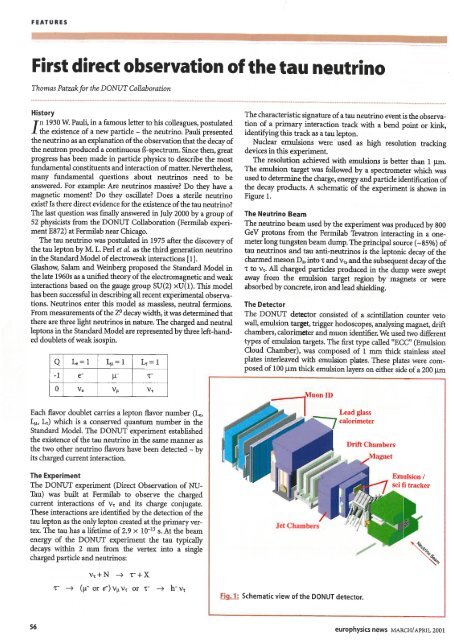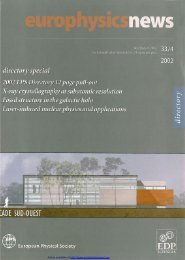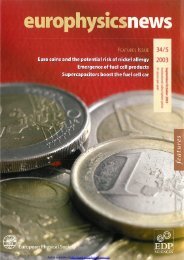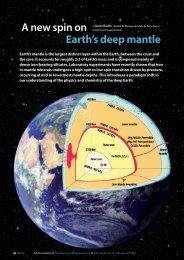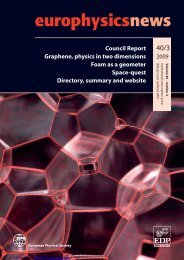Whole issue in PDF - Europhysics News
Whole issue in PDF - Europhysics News
Whole issue in PDF - Europhysics News
You also want an ePaper? Increase the reach of your titles
YUMPU automatically turns print PDFs into web optimized ePapers that Google loves.
FEATURES<br />
First direct observation of the tau neutr<strong>in</strong>o<br />
Thomas Patzak for the DONUT Collaboration<br />
History<br />
n 1930 W. Pauli, <strong>in</strong> a famous letter to his colleagues, postulated<br />
I the existence of a new particle - the neutr<strong>in</strong>o. Pauli presented<br />
the neutr<strong>in</strong>o as an explanation ofthe observationthat the decay of<br />
the neutron produced a cont<strong>in</strong>uous B-spectrum. S<strong>in</strong>ce then, great<br />
progress has been made <strong>in</strong> particle physics to describe the most<br />
fundamental constituents and <strong>in</strong>teraction ofmatter. Nevertheless,<br />
many fundamental questions about neutr<strong>in</strong>os need to be<br />
answered. For example: Are neutr<strong>in</strong>os massive? Do they have a<br />
magnetic moment? Do they oscillate? Does a sterile neutr<strong>in</strong>o<br />
exist? Is there direct evidence for the existence ofthe tau neutr<strong>in</strong>o?<br />
The last question was f<strong>in</strong>ally answered <strong>in</strong> July 2000 by a group of<br />
52 physicists from the DONUT Collaboration (Ferrnilab experiment<br />
E872) at Ferrnilab near Chicago.<br />
The tau neutr<strong>in</strong>o was postulated <strong>in</strong> 1975 after the discovery of<br />
the tau lepton by M. 1. Perl et al. as the third generation neutr<strong>in</strong>o<br />
<strong>in</strong> the Standard Model ofelectroweak <strong>in</strong>teractions [1].<br />
Glashow, Salam and We<strong>in</strong>berg proposed the Standard Model <strong>in</strong><br />
the late 1960s as a unified theory ofthe electromagnetic and weak<br />
<strong>in</strong>teractions based on the gauge group SU(2) xU(l). This model<br />
has been successful <strong>in</strong> describ<strong>in</strong>g all recent experimental observations.<br />
Neutr<strong>in</strong>os enter this model as massless, neutral fermions.<br />
From measurements ofthe ZO decay width, itwas determ<strong>in</strong>ed that<br />
there are three light neutr<strong>in</strong>os <strong>in</strong> nature. The charged and neutral<br />
leptons <strong>in</strong> the Standard Model are represented bythree left-handed<br />
doublets ofweak isosp<strong>in</strong>.<br />
Q 1.= 1 ~=1 Lt= 1<br />
-1 e- W r<br />
The characteristicsignature ofa tauneutr<strong>in</strong>o event is the observation<br />
of a primary <strong>in</strong>teraction track with a bend po<strong>in</strong>t or k<strong>in</strong>k,<br />
identify<strong>in</strong>g this track as a tau lepton.<br />
Nuclear emulsions were -used as high resolution track<strong>in</strong>g<br />
devices <strong>in</strong> this experiment.<br />
The resolution achieved with emulsions is better than 1 /lID.<br />
The emulsion target was followed by a spectrometer which was<br />
used to determ<strong>in</strong>e the charge, energy andparticle identification of<br />
the decay products. A schematic of the experiment is shown <strong>in</strong><br />
Figure 1.<br />
The Neutr<strong>in</strong>o Beam<br />
The neutr<strong>in</strong>o beam usedby the experiment was produced by 800<br />
GeV protons from the Ferrnilab Tevatron <strong>in</strong>teract<strong>in</strong>g <strong>in</strong> a onemeter<br />
long tungsten beam dump. The pr<strong>in</strong>cipal source (-85%) of<br />
tau neutr<strong>in</strong>os and tau anti-neutr<strong>in</strong>os is the leptonic decay ofthe<br />
charmed meson D s, <strong>in</strong>to 't and v~, and the subsequent decay ofthe<br />
't to v~. All charged particles produced <strong>in</strong> the dump were swept<br />
away from the emulsion target region by magnets or were<br />
absorbed byconcrete, iron and lead shield<strong>in</strong>g.<br />
The Detector<br />
The DONUT detector consisted of a sc<strong>in</strong>tillation counter veto<br />
wall, emulsion target, trigger hodoscopes, analys<strong>in</strong>g magnet, drift<br />
chambers, calorimeter and muon identifier. We used two different<br />
types of emulsion targets. The first type called "ECC" (Emulsion<br />
Cloud Chamber), was composed of 1 mm thick sta<strong>in</strong>less steel<br />
plates <strong>in</strong>terleaved with emulsion plates. These plates were composed<br />
of100 Jlrn thick emulsion layers on either side ofa 200 /lID<br />
0 v e VI' V~<br />
Each flavor doublet carries a lepton flavor number (Le,<br />
~, Lt) which is a conserved quantum number <strong>in</strong> the<br />
Standard Model. The DONUT experiment established<br />
the existence ofthe tau neutr<strong>in</strong>o <strong>in</strong> the same manner as<br />
the two other neutr<strong>in</strong>o flavors have been detected - by<br />
its charged current <strong>in</strong>teraction.<br />
The Experiment<br />
The DONUT experiment (Direct Observation of NU<br />
Tau) was built at Ferrnilab to observe the charged<br />
current <strong>in</strong>teractions of V~ and its charge conjugate.<br />
These <strong>in</strong>teractions are identified by the detection ofthe<br />
tau lepton as the only lepton created at the primaryvertex.<br />
The tau has a lifetime of 2.9 x 10- 13 s. At the beam<br />
energy of the DONUT experiment the tau typically<br />
decays with<strong>in</strong> 2 mm from the vertex <strong>in</strong>to a s<strong>in</strong>gle<br />
chargedparticle and neutr<strong>in</strong>os:<br />
v~+N ~ r+X<br />
r ~ (fl- or e-) vI' v~ or r ~ h-v~<br />
Fig. 1: Schematic view of the DONUT detector.<br />
S6<br />
europhysics news MARCH/APRIL 2001


